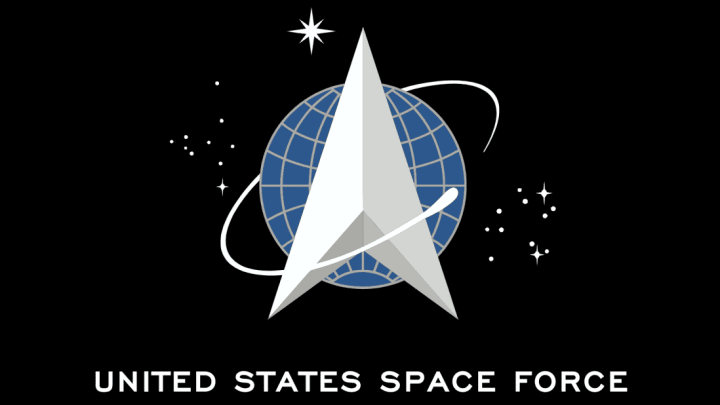On December 20, 2019, Donald Trump signed the 2020 National Defense Authorization Act, creating a sixth branch of the U.S. military: The United States Space Force (USSF). Reactions were mixed. Supporters heralded the dawn of a brave new era of space power, while critics called it an unnecessary and expensive campaign ploy that could provoke an arms race in space. Mostly, people posted memes.
The growing presence of humanity in space—or at least in high Earth orbit—has presented a whole host of potential problems and points of conflict. And the concept of protecting assets in space is nothing new. For decades, the U.S., Chinese, and Russian militaries have all placed significant resources into the defense of orbital assets and the militarization of space.
1. The United States Space Force isn’t the world’s first dedicated space force.
Russia has had variations of a dedicated space force since the early 1990s, beginning with the Russian Space Forces. In 2015, Russia merged its space force back into the Russian Air Force, creating the more cohesive and integrated Russian Aerospace Forces. China, meanwhile, established its PLA Strategic Support Force in 2015, which is responsible for space, cyber, and electronic warfare. While China and Russia both had dedicated and largely independent military arms for their space forces prior to the establishment of the USSF, the U.S. wasn’t entirely lagging behind. The USSF had actually existed within the United States Air Force since 1982, as the Air Force Space Command.
2. The United States Space Force won’t be fighting in space.
The USSF won’t be doing battle in space—at least not for now, and certainly not with power-suited space marines and boots on the moon. Todd Harrison, who directs the Aerospace Security Project at the Center for Strategic and International Studies, told NPR: “It's not about putting military service members in space, it has nothing to do with NASA, it's not about protecting Earth from asteroids or aliens.” The Space Force is more about protecting assets in orbit, such as satellites that gather intelligence, aid communications, detect missile launches, and provide GPS targeting for missiles.
3. The United States Space Force is led by the Chief of Space Operations.

The most senior officer in the Space Force is the Chief of Space Operations (CSO). In January 2020, General John W. Raymond was sworn in as the first CSO—and the first official member—of the Space Force. The 16,000 individuals assigned to the Space Force after Raymond’s appointment were all members of the former Air Force Space Command. Despite Trump’s description of space as a “war-fighting domain” and his calls for “American dominance in space,” General Raymond was quick to point out that the goal of the Space Force is to deter a conflict from extending into space, while adding that it was prepared to fight if needed.
4. The first United States Space Force doctrine seeks to define “Spacepower.”
In June 2020, the USSF published its first doctrine for space forces, entitled Spacepower [PDF]. It’s a slightly surreal read, with undertones of Starship Troopers (book or movie, take your pick) and subchapters covering everything from “War’s Enduring Nature” to “Space Warfighters” and the “Art of Space Warfare.” And while the doctrine assures the reader that the U.S. “desires a peaceful, secure, stable, and accessible space domain,” it doesn’t shy away from the fact that the Space Force is a military branch. For example: “Space mastery makes the military space community more lethal by enhancing the speed and focus of military spacepower.”
5. The united states Space Force seal looks like the Starfleet logo from Star Trek.
When the new Space Force seal was unveiled, social media had a lot of fun pointing out how similar it looked to that of Star Trek’s Starfleet Command. They are very similar, it’s true, but the Space Force seal was based on the existing Air Force Space Command logo, which dates back to 1982. The seal’s delta wing design, meanwhile, has been used by space organizations since 1961—five years before the first episode of Star Trek premiered.
6. The united states Space Force Motto is Semper Supra.

The Space Force motto, Semper Supra, means “Always Above.” According to the official Space Force Twitter account, the motto “represents [Space Force’s] role in establishing, maintaining, and preserving U.S. freedom of operations in the space domain.” For some people, that sounds gallant, striving, and reassuring. But it’s also possible to put an Orwellian spin on the Space Force motto, should one be feeling cynical about the ever-growing number of surveillance satellites. Seen in a more sinister light, “Always Above” does have a “we’re always watching you” kind of vibe.
7. The initial united states Space Force budget is just over $15 billion.
In February 2020, the Department of the Air Force released a $169 billion budget proposal for 2021. For the first time, the budget included funding for the fledgling Space Force, which had requested $15.4 billion. The Space Force budget included funding for missile warning satellites, next-generation GPS, and the development of a new tactical communications system. It also requested funding for the National Security Space Launch (NSSL) program, which seeks private companies—such as Elon Musk’s SpaceX and Jeff Bezos’s Blue Origin—to launch U.S. military and spy satellites into orbit.
